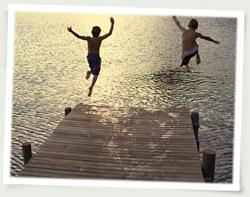
Flesh-eating Bacteria: How to know to protect yourself this summer!
Posted in General Health & Wellness on May 14, 2012. Last modified on March 26, 2019. Read disclaimer.
Imagine playing in the Tallapoosa River one day and then, within days, battling for your life against flesh-eating bacteria.
That's the nightmare transpiring for a University of West Georgia woman, after suffering a zip-cord mishap in the river on May 1, 2012. 24-year old Aimee Copeland was infected with aeromonas hydrophila, an antibiotic-resistant bacteria that thrive in warm and brackish waters of at least 30 US states.
+ Free Shipping & Returns on Eligible Items.
(*Amazon's Top 100 list updated hourly.)
Many of us have been exposed to Aeromonas but will never get sick -- and if we do, the most likely symptom is diarrhea that results from swallowing the water-borne bacteria.
Aeromonas can be much more destructive, however, when it infects deep recesses of the body that are not commonly exposed to bacteria, such as through a gash, cut or some form of skin opening. Here, the stealthy bacteria can reproduce rapidly, giving off toxins and shunting blood flow to parts of the body. Skin, fat, and muscle tissue may be destroyed and amputations may even be needed to save the individual's life.
A water-safety wake-up call
What makes this story especially concerning is that Aeromonas-infected waters are quite common, though cases of it destroying human flesh are extremely rare.
Streptococcus A is the type of bacteria usually associated with flesh-eating cases, so when symptoms first appear, "most doctors often aren't looking for Aeromonas," said Amy Horneman, an aeromonas expert and microbiologist at the Baltimore VA Medical Center. "This is the Rodney Dangerfield of pathogens. It doesn't get any respect either, (But) when a traumatic infection occurs involving a suitable body of water, that's the first organism you should think of."
Who is at-risk for this flesh-eating bacteria and what you can do to protect yourself?
You are at greater risk if:
- You have a weakened immune system from illness or cancer treatment, for example.
- You have a chronic health problem such as liver disease, diabetes, or kidney disease.
- Have deep cuts in your skin such as from a recent surgery or accident.
- Have recently had a viral disease that includes a rash such as chickenpox or shingles.
- You are taking steroids to suppress the immune system for the treatment of another disease.
- You handle fish regularly such as fish hatchery workers and fishermen, since Aeromonas hydrophila is primarily a fish borne illness.
- You engage regularly in water sports such as kayakers, boaters, and swimmers.
Symptoms to be aware of
If you do become infected, symptoms often start suddenly after an injury. If you have pain that gets better then gets much worse over 24 to 48 hours, you must get immediate medical attention. The pain may be much worse than expected from the level of injury. Look for:
- Skin that is red, swollen and hot to the touch
- Chills and Fever
- Stomach symptoms such as nausea and vomiting
- Diarrhea
Although there is no such thing as 100% prevention of acquiring a resistant flesh-eating microorganism, here are steps that may decrease your risk.
How to protect yourself
If you cut yourself in the water, be sure to thoroughly wash the wound in clean water (not from the lake or stream). Apply antibiotic ointment and dress the wound to keep it dry and clean. Most importantly, with a puncture or deep wound, stay out of fresh water lakes and streams (and even ocean water) until the wound has healed. And to guard against the more common type of aeromonas that occurs from swallowing the bacteria, following good sanitation practices are key: wash your hands with soap and water before eating or preparing food.
"It's one of the few true infectious-disease emergencies where an hour can make a huge difference," said Otto Yang, an infectious-diseases physician at UCLA's David Geffen School of Medicine.
Want to learn more? Watch MSN.com's interesting video about a related flesh-eating bacteria.Sources (Accessed May 14, 2012)
http://www.nnff.org/nnff_what.htm
http://www.webmd.com/a-to-z-guides/necrotizing-fasciitis-flesh-eating-bacteria-topic-overview?page=2
http://www.thedailybeast.com/articles/2012/05/11/georgia-woman-fights-for-life-against-flesh-eating-bacteria.html
http://www.webmd.com/a-to-z-guides/necrotizing-fasciitis-flesh-eating-bacteria-topic-overview?page=2
http://news.yahoo.com/georgia-woman-24-battles-flesh-eating-disease-200835702.html
http://www.thedailybeast.com/articles/2012/05/11/georgia-woman-fights-for-life-against-flesh-eating-bacteria.html
http://www.webmd.com/a-to-z-guides/necrotizing-fasciitis-flesh-eating-bacteria-topic-overview?page=2
http://en.wikipedia.org/wiki/Acriflavine
http://en.wikipedia.org/wiki/Aeromonas_hydrophila
http://microbewiki.kenyon.edu/index.php/Aeromonas_Hydrophila
http://aem.asm.org/content/36/5/731.abstract
http://nithacom.sasktelwebhosting.com/attachments/article/31/Aeromonas.pdf

 Exercise and your immune system
Exercise and your immune system Flesh-eating bacteria in Georgia river
Flesh-eating bacteria in Georgia river Flesh-eating bacteria infographic
Flesh-eating bacteria infographic How to control chronic inflammation
How to control chronic inflammation How to stop worrying
How to stop worrying Strength or endurance exercise?
Strength or endurance exercise? Controlling stress in the workplace
Controlling stress in the workplace Special nutritional needs of children
Special nutritional needs of children Healthy alternatives to soft drinks
Healthy alternatives to soft drinks Small space gardening
Small space gardening Preventing falls in the home
Preventing falls in the home Refreshing, fizzy fruit drink recipes
Refreshing, fizzy fruit drink recipes Ancient lessons for modern living
Ancient lessons for modern living